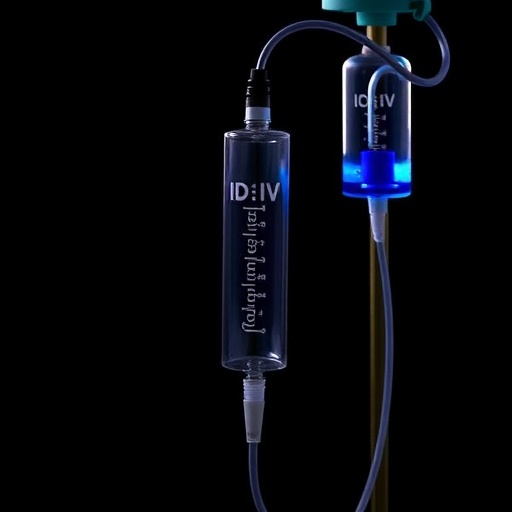Intravenous therapy nursing is a critical component of healthcare that directly impacts patient safety and treatment efficacy. Recognizing the need for enhanced quality assurance within this field, a groundbreaking study led by Zhang, Y., Zhao, R., Sun, H., and their team, has culminated in the establishment of a comprehensive quality evaluation indicator system specifically tailored for intravenous therapy nursing. This innovative framework aims to boost the standards of care delivered by nursing professionals, ultimately leading to improved patient outcomes.
The significance of intravenous therapy (IVT) within hospital settings cannot be overstated. IVT facilitates the administration of vital medications, fluids, and nutrients directly into the bloodstream, making it essential in managing varied medical conditions ranging from dehydration to administering chemotherapy. However, ensuring the quality and safety of IVT practices is paramount, as any deviation from established protocols can lead to serious complications, including infections, thromboembolism, or even fatalities.
The researchers initiated their endeavor by thoroughly analyzing existing methodologies employed in the evaluation of intravenous therapy systems across various institutions. Through meticulous literature reviews and the synthesis of data from diverse healthcare environments, they identified gaps in quality measurements that have previously stunted advancements in nursing practices. This foundational work paved the way for the integration of a more unified approach to quality assessment in intravenous therapy nursing.
A key aspect of the newly proposed quality evaluation indicator system is its multidimensional nature. Rather than relying on singular metrics, this system encompasses a wide array of indicators, thereby allowing a comprehensive assessment of nursing activities. It incorporates elements like technical skills proficiency, patient communication, adherence to safety protocols, and follow-up care which collectively contribute to the quality of intravenous therapy provided to patients. This holistic approach is designed to address the complexities inherent in nursing care and enhance the effectiveness of training programs.
Moreover, one of the notable advancements within this research is the incorporation of real-time feedback mechanisms aimed at fostering continual improvement among nursing staff. By using technology to monitor and evaluate the performance of healthcare workers on an ongoing basis, the system allows for immediate identification of areas requiring attention. Through the introduction of mobile applications and digital platforms, nurses can receive instant updates and direct feedback regarding their iv therapy techniques, thereby making corrective measures possible in real-time.
In addition to metrics concerning nursing practices, the indicator system also emphasizes the importance of patient-centered care. Indicators within the framework focus on patients’ experiences and satisfaction relating to their intravenous therapy treatment. Collecting data through patient surveys enhances understanding regarding their perceptions of care and the emotional aspects involved in the treatment process, thereby ensuring that patient needs are prioritized.
The researchers also sought to validate the quality evaluation indicator system through rigorous testing and application within a clinical context. Conducting pilot studies in various healthcare facilities provided practical insights on how the standardized indicators function in real-world settings. Feedback from clinical staff and patients during these trials was invaluable, guiding necessary adjustments to the system while affirming its functionality and relevance.
The anticipated impact of this quality evaluation indicator system extends beyond nursing practices; it carries implications for hospital-wide practices that involve intravenous therapy. When nursing care is improved, it results in elevated patient safety levels, consolidated treatment pathways, and ultimately, reduced healthcare costs due to decreased complication rates. As hospitals seek to enhance their overall service quality and fulfill regulatory requirements, such evaluations will become indispensable tools for continuous quality improvement.
Furthermore, the successful implementation of this framework may generate interest among other healthcare disciplines. The methodology and principles employed in constructing the quality evaluation indicator system can serve as a model for evaluating different facets of medical care, inspiring future research initiatives aimed at enhancing care quality in various settings, thereby leading to a widespread elevation of nursing standards across the board.
In an era where patient safety is paramount and healthcare complexities are constantly evolving, the introduction of rigorous evaluation frameworks such as the quality evaluation indicator system becomes increasingly essential. Zhang and colleagues not only offer a systematic approach to addressing existing deficiencies but also lay the groundwork for ongoing advancements in nursing care and patient satisfaction throughout intravenous therapy treatments.
As the researchers continue to refine their system, further studies will be conducted to explore the long-term impacts and sustainability of the quality evaluations in multiple healthcare environments. The overarching goal remains clear: to develop methodologies that inspire and facilitate superior nursing practices, ultimately transforming the landscape of intravenous therapy across the globe.
Ultimately, the establishment of this quality evaluation indicator system presents an optimistic pathway towards revolutionizing intravenous therapy nursing. The culmination of research, clinical testing, and feedback has produced a robust methodology that holds promise not only for improving patient outcomes but for establishing a holistic standard of excellence in nursing care overall. The healthcare community stands to benefit tremendously, reinforcing the notion that continual improvements in nursing practice lead to lasting positive change in patient care.
In conclusion, intravenous therapy is a cornerstone of effective healthcare delivery, and ensuring the quality of this care through structured and well-researched systems will have profound implications for the future of nursing and patient safety. The work done by Zhang, Zhao, Sun, and their colleagues represents a significant leap forward in ensuring that nursing professionals are equipped with the tools necessary to provide the highest quality of care to their patients.
Subject of Research: Quality evaluation indicator system for intravenous therapy nursing.
Article Title: Construction and application of a quality evaluation indicator system for intravenous therapy nursing.
Article References:
Zhang, Y., Zhao, R., Sun, H. et al. Construction and application of a quality evaluation indicator system for intravenous therapy nursing.
BMC Nurs (2025). https://doi.org/10.1186/s12912-025-04149-8
Image Credits: AI Generated
DOI:
Keywords: Quality assessment, intravenous therapy, nursing practices, patient safety, healthcare innovation.




